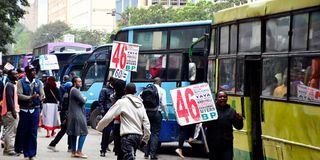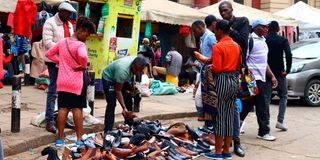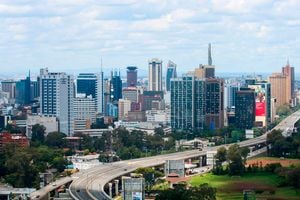
Boda boda riders drive on the wrong side of the road past a Nairobi County Traffic Enforcement Officer who is on a phone call on Moi Avenue on April 4, 2024.
The girl was young, perhaps in her mid-20s, and so she still had that youthful spring in her step. She was walking along Moi Avenue a few minutes past midday yesterday when she decided to dart across the road.
She made it past the vehicular chaos of the service lane a few metres past Hotel Ambassadeur, across the Moi Avenue lane that heads towards the Railways Roundabout, and onto the median.
She looked left as she stood on the median, the narrow strip of land that separates the opposite lanes of the road. Two cars passed, and then she jumped onto the lane. She had barely made two steps when she heard the screeching sound of tyres against tarmac and the screaming epithets of an enraged man.

She turned right just in time to see the man riding a bicycle, and behind him a boda boda careering towards her on the wrong side of the road. They both gave her that red-eyed menacing look as they swerved to avoid hitting her, and as she made the dash across the remainder of the road, they rode on and disappeared into the thick of the Railways Roundabout. She had made it, but only just.
A few metres away, at the seat of the County at City Hall, Governor Johnson Sakaja, was preparing to give his State of the County address, an annual ritual adopted by rulers to share their versions of progress reports and reiterate their commitment to deliver on their election promises.
That episode on Moi Avenue lasted less than 10 seconds, but it was a powerful metaphor for what has become of Nairobi, an African metropolis that appears to be teetering on the edge of disaster.

In the three-or-so hours that we toured the city, we came face-to-face with streetwise unruliness, crumbling infrastructure, the ireful gaze of livid council askaris, snail-pace traffic, and chaos that made apocalyptic scenarios seem like child play.
Nation photographer Sila Kiplagat immortalised this urban bedlam in a series of photos as we walked around the city to talk to its residents about their fears, hopes and misgivings about Mr Sakaja’s city.
We had barely stepped outside Nation Centre when we saw an old Land Rover break-down truck reverse at high speed to block a motorist who was pulling out of a parking slot on Kimathi Street. Four men, two in City Council Inspectorate uniform and the other two in civilian attire, jumped out of the truck, registration number KTH 697, and started confronting the driver.

City inspectorate officers are required by law to only use official vehicles for patrol and clamp-downs, but unruly officers often collaborate with private break-down services to harass motorists and impound their cars. The askaris let go of the driver after the commotion attracted members of the public, but as they drove off in their rickety truck, it was clear that Mr Sakaja’s directive soon after assuming office in November 2022 that city council inspectorate should stop harassing motorists no longer held.
And that is not the only pledge that the Governor is being accused of not meeting. To audit Mr Sakaja, one needs to go back to his colourful manifesto, which is available on the Nairobi City County website. By recent standards, Mr Sakaja’s campaign was messianic. He promised order, dignity and hope to the millions who call Nairobi home, and on social media insisted “lazima iwork”.

It didn’t take long, however, for some to start complaining that Mr Sakaja was all dimples and no charm. With his directive, in November 2022, that City Hall should stop impounding boda bodas and rogue passenger service vehicles, he opened up the city for abuse. Thousands of boda bodas have now taken over city streets. They ride everywhere, hog entire streets, park anywhere, harass vehicular motorists, and maim pedestrians.
Yesterday on every road we passed, we were forced to play a game of hit-or-miss with boda bodas riding on wrong sides of the road, on pedestrian walkways, under shop canopies, on road medians… basically, everywhere, and often under the watchful eyes of traffic police officers and city inspectorate askaris.
Nowhere is the damage they are causing to city infrastructure more evident than on the median of Kenyatta Avenue between the junction with Ngong Road and the roundabout with Uhuru Highway. Here, and every day, thousands of boda bodas ride on the median, and while their weight might seem inconsequential, they have pounded the tarmac to smithereens. What was once a neat divider has now been turned into a dusty stretch during the dry season, and a soggy mess when it rains.

Such damage is also starting to appear on other medians and pavements in the city, and even though in January this year Mr Sakaja announced a multi-million-shilling investment to overhaul city walkways and pave them with cabro bricks, little is being done to keep the riders off these delicate spaces.
A rider told us yesterday that the city roads are unnavigable, even for them. And he appeared to have been right. Changes in the zoning of the city have unleashed gaudy buses into its streets. Until three years ago no PSVs were allowed to park on Moi Avenue, but now they occupy the entire stretch from Khoja Mosque all the way to the Railways Roundabout. Tom Mboya Streets long went to the dogs, while Kenneth Matiba Street, formerly known as Accra Road, is choc-a-bloc with PSV traffic.
This zoning disaster has made downtown Nairobi lose it lustre, and in fact many motorists avoid driving on the sector between Moi Avenue and Kirinyaga Road. There have been attempts to correct the mistake, but these often end up being swallowed by the populist agendas of politicians.

A boda boda rider on the wrong side of the road in Nairobi CBD on April 4, 2024.
In July 2020, for instance, the County Assembly of Nairobi passed a motion to remove all on-street picking and dropping zones by the PSVs and bodabodas within the Central Business District, but this dream was soon shelved at the height of the campaigns.
Woodley MCA Mwangi Njihia had argued at the time that most streets, pedestrian walkways and on-street parking in the city centre had been illegally turned into bus stops and parking slots for passenger service vehicles, leading to congestion and, in extreme cases, fatal accidents.
Yesterday, the Nation noted that buses had been allowed to take up almost the entire breadth of the street at the Kencom stop. Initially, buses were only allowed to drop and pick passengers here, and to only parallel-park for a few seconds as they did so. Now they are allowed both angle and perpendicular parking, which means their frames extend from the kerbs and gobble up half of the road behind them.

Matatu touts call out for customers at the Kencom bus stop in Nairobi.
At the same time, hawkers now rule the streets. Initially kicked out of the city centre, they have been allowed to colonise entire streets. From the entire stretch of Tom Mboya, to Ronald Ngala, to Mfangano, to Sheik Karume, to Kenneth Matiba, to Latema, to Lagos and every stretch in between, hawkers trade their wares unperturbed, and in broad daylight.
Every now and then a city council inspectorate vehicle passes by, and every now and then the hawkers quickly retreat, only to emerge a few minutes later and to spread their wares on the road and on pavements.
Mr Robert Ngugi is livid. He runs a small shop on River Road that sells assorted stuff, from electrical fittings to mobile phone accessories to refreshments and airtime tokens. Every morning when he comes to work, he finds hawkers selling the same stuff he is selling right outside his door, and while he has protested against what he calls “an invasion”, the hawkers have stayed put.

Hawkers sell their wares near the Kenya National Archives along Tom Mboya Street.
“I pay an annual licence to City Hall every year to run this business,” laments Mr Ngugi. “That license is not just for me to run this business, it also confers an obligation to City Hall to protect my premises and provide me with a good working environment. What’s the point of paying for this licence if I cannot run my business?”
But the hawkers disagree with Mr Ngugi’s statement. At the junction of Latema Road and Lagos Road yesterday, we found a group of hawkers who had sprawled their ware on the road. All of them were selling second-hand clothes, which they said they source from Gikomba every morning.
One young woman, who refused to tell us her name, said she was frustrated by the way society treats those who make a living from hawking.
“I am not here because I want to,” she protested. “I am here because this is all I have. I have gone to school and I have a diploma in hospitality and another one in procurement, but I have not been employed since 2015. What do you want me to do!”
“But should your business affect the general well-being of the city and inconvenience other people?” we asked her.
“I am not an inconvenience,” she opposed as she arranged her stock of second-hand blouses on a small mat on the road. “I am a mother. I have a child at home yet I can barely provide for her. This keeps me going, but it is hardly enough for us. So I am here because I have to survive.”
Yesterday, Mr Sakaja, in his address, agreed that Nairobi deserves better, and promised to make life a more dignified experience for its residents.
“We grew up in a city that was orderly; in which there was community because neighbours knew and cared for each others’ families; and in which public services worked,” noted the governor. “The quality of municipal governance made our family life possible. We were grateful. Nairobians want a city of order, of dignity, of hope and of opportunity. A city where everyone knows and obeys the rules; where no one is subjected to indignity and humiliation; a city of hope, and of opportunity for all. That is the county I want. That is the county that all the leaders gathered here want. As leaders, we are responsible for achieving it.
By 2050, Mr Sakaja said, Nairobi will have at least 10.5 million inhabitants, and so to avoid urban sprawl and its concomitant negative effects, “we must rethink and redesign many of our neighbourhoods”.
“Our city of 696 square kilometres will not expand,” he said. “We must use available technology to ensure sustainable housing even as we raise height restrictions in different parts of the City. We can only go up. The process of review of these plans, which will bring together our urban planners, residents’ associations and other professionals, must take these facts into consideration.”
But Nairobi wasn’t always this chaotic place where people fought to establish a foothold. Founded in 1899 as a rail depot on the railway line from Mombasa to Uganda, it quickly grew from a swampy resting place for the Indian coolies building the railway to the administrative headquarters of the East African Protectorate.
Machakos, the small town 60 kilometres away from the city, had initially been designated as the capital city of Kenya. It was well located, with a backyard of plains that extended all the way from its steps to the Kapiti and Konza plains, and hence had room for growth. But that plan was quickly shelved when the railway bypassed Machakos by about 20 kilometres, rendering it just another African backwater town that had no commercial, political or social value at the time.
In the hierarchy of African metropolises, Nairobi is now not even among the 10 biggest by population. The top five are Kinshasa, Lagos, Cairo, Giza, Luanda and Dar es Salaam, even though some data sheets do not categorise Giza, in Egypt, as a city and so give the fifth slot to Khartoum.
But where it lacks in human numbers, Nairobi makes up for it with human skills and a fantastic location. Before Addis Ababa overtook it as the region’s preferred aviation hub, Nairobi served not just East Africa, but also Central and West African aviation markets through the national carrier, Kenya Airways. Its comparatively better-skilled human resource still makes it a melting pot of financial, engineering, information technology, communication and research professionals, and is ranked at the fifth richest city in Africa by Henley & Partners, behind Johannesburg, Cairo, Cape Town and Lagos.
It’s successes and failures are, therefore, not a Kenyan affair, but an African and, indeed, a global one. Governor Sakaja has promised to transform this bustling African metropolis into a modern city, but his missteps in getting the infrastructure right, sealing the potholes, organizing public transport, cleaning the backstreets, fighting crime and generally bringing order to the country’s seat of power are chipping away on its fortunes.
And that, is a bad State of Nairobi City County.












